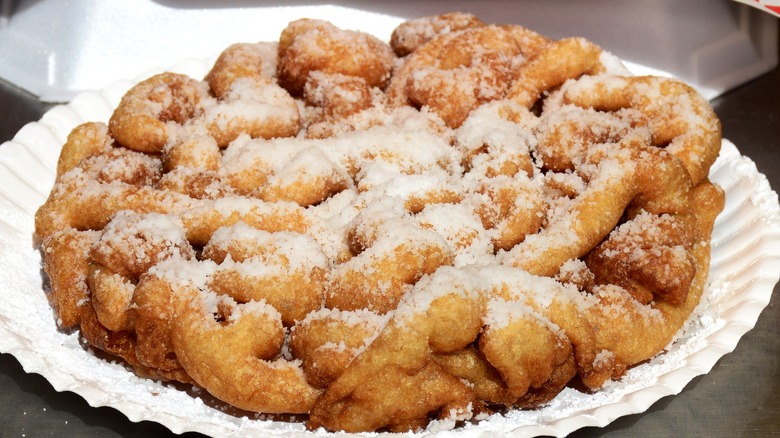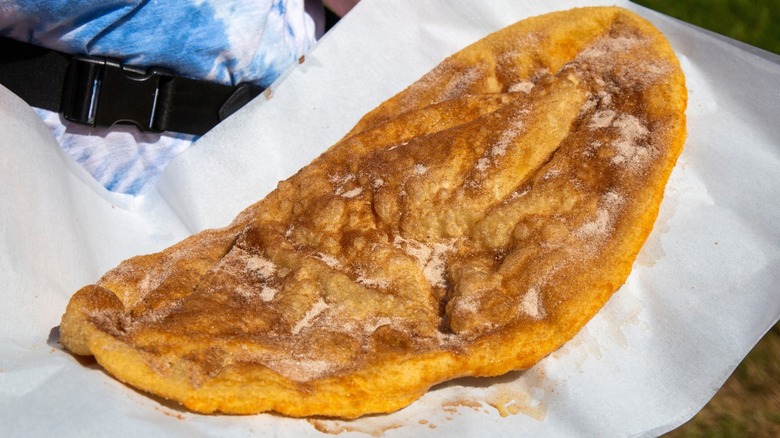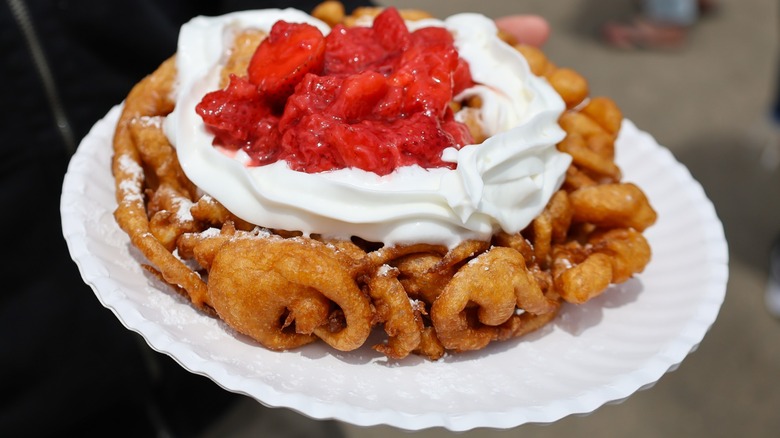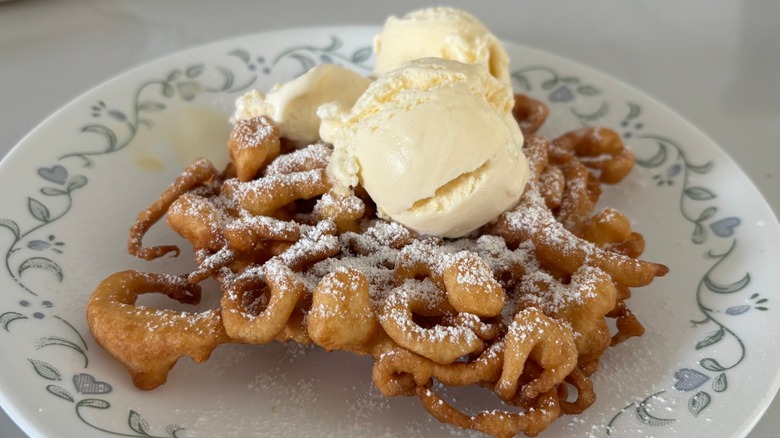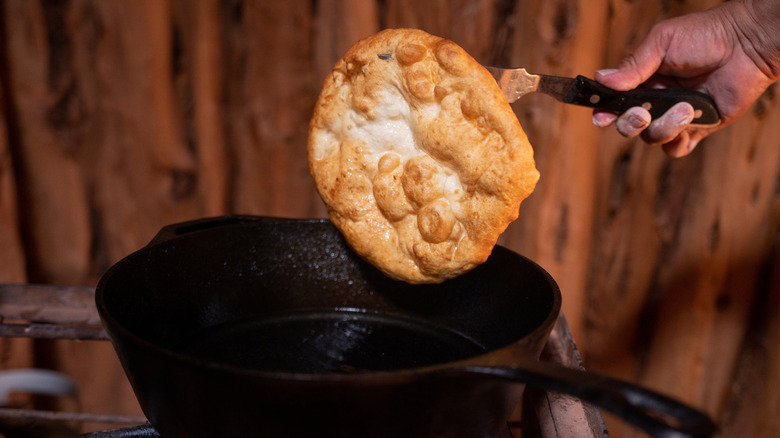Funnel Cake Vs Elephant Ears: What's The Difference?
Whether you're getting food and drinks on Coney Island or exploring the best restaurants on Chicago's Navy Pier, these boardwalk staples are BYOSF — bring your own sticky fingers. If you're at a county fair or amusement park, you'll want to wait at least 30 minutes before hopping on the Tilt-a-Whirl after eating either of these bad boys. We're, of course, talking about the confectionery kings of the carnival: funnel cakes and elephant ears. Both treats are airy, crisp, fried, lightly sweetened, and enticingly aromatic. It's not a carnival until you can smell the fried dough of these classic fair foods from 500 yards away.
So, what makes these doughy beauties different? Funnel cakes are essentially a long tube of fried dough coiled on top of itself into a pile and dusted with a mountain of powdered sugar to serve. Meanwhile, elephant ears are thinner, flatter, softer ovals of fried dough sprinkled with lots of cinnamon and granulated sugar. But this is just the most obvious difference between the dynamic duo of fairground dining. These warm, sweet treats may be simple to make, but there's a lot to unpack surrounding their ingredients, preparations, and histories.
What is funnel cake?
Funnel cake is a dessert made from fried batter sprinkled with a heap of powdered sugar. The soft sugar slightly melts into the still-warm dough for a sweet, rich bite that's subtly savory thanks to the frying oil. Funnel cake batter is a simple combination of flour, eggs, baking powder (to help the batter rise), and milk, which then gets fried in a neutral cooking oil like vegetable, canola, soybean, or safflower oil. Alternatively, funnel cakes are also commonly made from French choux pastry, the same puffy dough used to make cream puffs and eclairs, which combines flour, eggs, butter, and water.
Funnel cake's name and signature interwoven pattern come from (surprise) a funnel, which is a crucial element in how this treat is prepared. To make it, the batter is passed through the funnel into the hot oil, creating tube-like shapes of golden brown fried dough. Typically, the dough is poured through the funnel into the hot oil in a widening circular pattern roughly the size of the paper plate on which it's destined to be served. Cinnamon and salt are also commonly stirred into the batter or sprinkled on top of the finished funnel cake. In addition to powdered sugar, other less traditional toppings can include whipped cream, sprinkles, maple syrup, chocolate sauce, fresh fruit, jelly, or even a scoop of vanilla ice cream.
What are elephant ears?
Elephant ears are large, thin, oblong pieces of fried dough named after their resemblance to, you guessed it, an elephant's ears. Elephant ears are sprinkled with a generous layer of granulated sugar and cinnamon to serve. To be clear, we aren't talking about palmiers here, even though these French cookies are also commonly referred to as "elephant ears." Local periodical Indianapolis Monthly published an official recipe for Indiana State Fair Elephant Ears, and the batter combines milk, salt, sugar, shortening, flour, and active dry yeast, all fried in canola oil. To assemble, the shortening gets melted into the milk, sugar, and salt, then the yeast is added to the mixture and left to rise into a ball of pliable dough.
Made the traditional way, the risen dough is broken down into two-inch balls, rolled ultra-thin, then dropped in hot oil to fry to a flaky, golden brown crisp. Although, for making elephant ears in large quantities at county fairs and other events, the Indianapolis Monthly recipe suggests making 'em using a stand mixer with a dough hook, which majorly expedites the process compared to kneading by hand. For a shortcut, if you're making carnival-worthy elephant ears at home, you can also use store-bought refrigerated (defrosted) puff pastry dough here and keep the yeast in the cabinet.
Funnel cakes are chewy heaps of coiled dough, and elephant ears are soft, flat ovals
The most immediately obvious difference between funnel cakes and elephant ears is their shapes. Funnel cake is an interwoven tube made from fried dough piled on top of itself into an oblong heap. Elephant ears are a single layer of oval-shaped fried dough, structurally not dissimilar to a pancake. By extension, another key difference between these treats is their textures, with funnel cakes presenting a much greater surface area of fried dough for a toothy, crispy, chewy bite, and elephant ears being a much softer bite, made even more delicate by the presence of some type of shortening in the dough (an ingredient absent from funnel cake batter).
Shortening can be any fat that is solid at room temperature, including lard, margarine, and vegetable shortening like Crisco, and it serves a highly scientific purpose when added to dough. Shortening is worked into dough to prevent long, chewy strands of gluten from forming (it's literally "shortening" the dough), which makes for a crumbly, meltaway texture in baked goods like shortbread cookies and pie crusts. In elephant ears, the shortening creates both a plush interior dough and a crispy outside when fried – which stands in marked contrast to chewy, toothy funnel cake. Funnel cakes also have greater potential for different flavorful toppings compared to elephant ears, which are pretty much always served with cinnamon and sugar alone.
Funnel cakes have roots in the Pennsylvania Dutch community
Funnel cakes appeared in America in the Midwest sometime during the late 1800s. The treat has ties to the Pennsylvania Dutch community, and before it arrived in the U.S., it can be traced to similar confectionery classics in Europe like the German striebele and the Finnish tippaleipä. Versions of funnel cakes date back to Medieval times, appearing in Anglo-Norman cookbooks, including the 1390 Middle English cookbook "The Forme of Cury," via Tori Avey. In most manuscripts from this era, proto-funnel cake appears as mincebek or mistembec, which can be connected to the Old French "mis en bec."
This translates to "put in (set) spout," ostensibly a nod to the funnel through which the dough passes into the hot oil. Funnel cakes broke onto the American sweet-toothed scene at large with the advent of the Kutztown Folk Festival, an annual event that originated in 1950 organized with the goal of promoting regional Pennsylvania Dutch culture. The celebration became wildly popular, with each festival selling thousands of funnel cakes, and the rest is literally history. Today, the Kutztown Folk Festival lasts eight days and remains the oldest continuous folklife festival in the country.
Elephant ears are culturally significant in Native American heritage
Elephant ears can be traced back to traditional Native American fry bread, which originated during the mid-1800s. Despite the playful connotation that elephant ears have come to adopt as a county fair treat, fry breads are a symbol of Indigenous peoples' ingenuity and resourcefulness in survival against the American government. When the Navajo people were displaced en masse from Arizona to New Mexico during the infamous 300-mile trek, aka the "Long Walk" of 1854, the new ground was unfit for cultivating the crops they were used to eating and cooking with as part of their staple diets.
Faced with starvation, the government sent the Navajo people boxes of canned goods, white flour, processed sugar, and lard. The ability of these dry ingredients to actually sustain people is questionable, but from those boxes, fry bread was created, and it became a staple of Navajo culture. The dish remains a complicated symbol of triumph and the ongoing fight for quality of life, though it's unclear exactly when or where fry bread morphed into elephant ears and made its way to amusement parks.
Potential signs point to a Navajo fair held in the 1960s as the treat's springboard onto the larger American food scene. According to an article published in the Navajo Times, "The celebration held by the tribe in the summer of 1968 attracted a lot of national attention as big city newspapers as well as a number of travel and other magazines did features on fry bread and its [effects] on the Navajo population over the next century."

